

Germany pushes for tax hike on meat and cheese. Ooho! - water in edible bubble. Cost of cigarettes must rise to reflect environmental damage from tobacco industry, WHO says. The price of a packet of cigarettes should rise to reflect the wide-ranging environmental damage caused by the tobacco industry, from deforestation to water pollution, a major report has recommended.
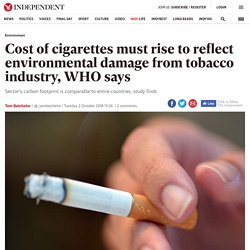
Backed by the World Health Organisation (WHO), the study found the industry’s carbon footprint was comparable to entire countries. Tobacco farms accounted for the loss of around 5 per cent of forests in parts of Asia and Africa, it stated. The UK was among the countries singled out for criticism along with several other western nations which were condemned for “literally burning poorer countries’ resources”. Cigarette production and consumption have seen dramatic growth in recent decades with around six trillion cigarettes manufactured annually for an estimated one billion smokers. Tobacco production is often more environmentally damaging than that of essential commodities such as food crops, the study by the WHO Framework Convention on Tobacco Control found. The people fighting pollution with plastic-free periods. Are there chances of an increased use of E-mobility on the horizon? VW launches We Share electric car sharing service.
The ‘Eco-Friendly’ Trend is Affecting the Way Brands Appeal to Consumers. How the ‘Eco-Friendly’ Trend is Affecting Brand Appeal.
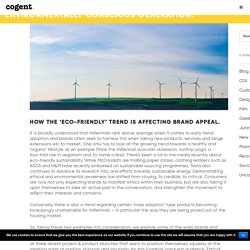
It is broadly understood that millennials rank above average when it comes to early trend adoption and brands often seek to harness this when taking new products, services and range extensions etc to market. One only has to look at the growing trend towards a healthy and ‘organic’ lifestyle as an example (think the millennial avocado obsession, rooftop yoga, a four-fold rise in veganism and, to name a few). There’s been a lot in the media recently about eco-friendly sustainability. While McDonald’s are trialling paper straws, clothing retailers such as ASOS and H&M have recently embarked on sustainable sourcing programmes.
Tesla also continues to advance its research into, and efforts towards, sustainable energy. Conversely, there is also a trend regarding certain ‘mass adoption’ type products becoming increasingly unattainable for millennials – in particular the way they are being priced out of the housing market. Sustainable Luxury: Millennials Buy Into Socially Conscious Brands. The luxury industry is often tied in with terms like excessive consumerism, disposable income, and guilty pleasures.
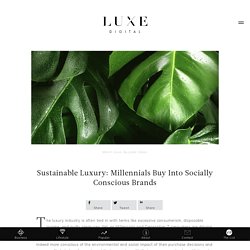
Yet, as Millennials and Generation Z consumers are driving 85 percent of global luxury sales growth, their expectation for luxury brands to be aligned with their values becomes increasingly important. The younger affluent generations are indeed more conscious of the environmental and social impact of their purchase decisions and are more likely to buy from a brand that resonates with their own personal values. Going ethical: The new strategy brands use to lure millennials. Consumers are increasingly opening up their wallets for the intangible promise of ethical manufacturing practices, healthier lifestyles and concern for the environment.
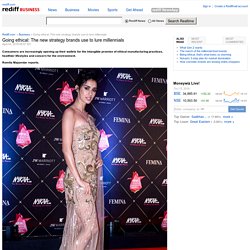
How Young People Are Changing the Fashion Industry. Reformation's Camille Dress, made from a TENCEL™ Lyocell/viscose/organic cotton/polyester/lycra blend, saves about 1,558 gallons of water compared to a similar, conventionally made dress. | Image credit: Reformation New York Fashion Week is here and there is a growing fashion movement that has the potential to fundamentally change the industry: sustainable fashion.
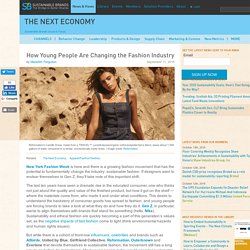
If designers want to endear themselves to Gen Z, they’ll take note of this important shift. The last ten years have seen a dramatic rise in the educated consumer, one who thinks not just about the quality and value of the finished product, but how it got on the shelf — where the materials come from, who made it and under what conditions. Gen Z’s Passion for Sustainable Products Is Fueling the Shift Toward Streetwear. Greener Than You: Boomers, Gen X & Millennials Score Themselves On The Environment.
Consumers Going Green: Everything You Need to Know. The Evolution of the Sustainability Mindset. A new era of sustainability is rising and it’s touching every corner of the world.
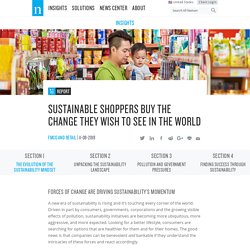
Driven in part by consumers, governments, corporations and the growing visible effects of pollution, sustainability initiatives are becoming more ubiquitous, more aggressive, and more expected. Looking for a better lifestyle, consumers are searching for options that are healthier for them and for their homes. The good news is that companies can be benevolent and bankable if they understand the intricacies of these forces and react accordingly. The challenge is this: sustainability is a broad, all-encompassing term and it’s often difficult to know where to start. This report highlights what consumers care about when it comes to sustainability, the biggest growth opportunities for manufacturers and the differences among consumer sentiments across markets.
In a recent global online survey, a whopping 81% of global respondents feel strongly that companies should help improve the environment. Millennials: is ‘green’ your colour? “Do as I say, not as I do” - a systematic literature review on the attitude behaviour gap towards sustainable consumption of Generation Y.